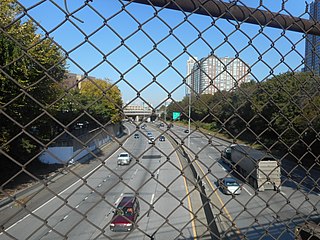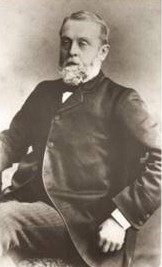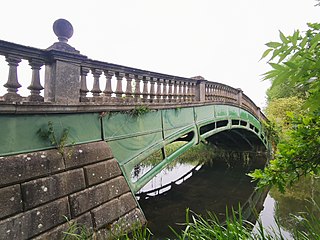
A chain-link fence is a type of woven fence usually made from galvanized or linear low-density polyethylene-coated steel wire. The wires run vertically and are bent into a zigzag pattern so that each "zig" hooks with the wire immediately on one side and each "zag" with the wire immediately on the other. This forms the characteristic diamond pattern seen in this type of fence.
The Garrard & Blumfield or Blumfield & Garrard was an English electric car manufacturer from 1894 to 1896. The company is presumed to have been founded by C. R. Garrard and T. W. Blumfield.

Newton, Chambers & Co. was one of England's largest industrial companies. It was founded in 1789 by George Newton and Thomas Chambers.
Whessoe is a company based in Darlington and on Teesside in North East England. It was formerly a supplier of chemical, oil and nuclear plant and instrumentation, and today is a manufacturer of low temperature storage.
Perry & Co., Ltd was a dip pens manufacturer of England. The company was the largest in its country of origin, producing a huge range of models. Perry & Co. also manufactured bicycle chains and accessories.

Robinson Thwaites was a nineteenth-century mechanical engineer and mill-owner in Bradford, Yorkshire. His companies included at different times Robinson Thwaites and Co, Thwaites and Carbutt and Thwaites Brothers.

Fielding & Platt was a firm of hydraulic engineers who were an important part of the manufacturing sector in Gloucester until the 1990s. Started by two Lancashire men, Samuel Fielding and James Platt, the firm exploited the portable hydraulic rivetting technology of Ralph Hart Tweddell to build a business that exported hydraulic machinery worldwide. Apart from the wide range of items made, the firm was particularly noted for the quality and long-life of their products.
Hazledine and Company was an ironworks in Bridgnorth, Shropshire, England. It was set up about 1792 by three brothers: John Hazledine (1760–1810), Robert Hazledine (1768–1837) and Thomas Hazledine (1771–1842). Sources differ about the partnership - Discover Shropshire claims that the partners were John Hazledine, William Hallen and John Wheeler.

The 1825 to 1863 Stockton and Darlington Railway (S&DR) was the world's first public railway to use steam locomotives. Its first line connected collieries near Shildon with Stockton-on-Tees and Darlington, and was officially opened on 27 September 1825. While coal waggons were hauled by steam locomotives from the start, passengers were carried in coaches drawn by horses until carriages hauled by steam locomotives were introduced in 1833.
Joseph Salmon was a British bookseller turned postcard publisher and printer, and the founder of J Salmon Ltd in 1880, the UK's oldest postcard and calendar publisher.

James Cross and Company was a locomotive building company established around 1863 at Sutton Engine Works, St. Helens, England. The partners were James Cross, Edward Borrows and Arthur Sinclair, all of whom were former employees of the St Helens Railway. The company is notable for having built the first double Fairlie locomotive.

Andrew Spottiswoode was a Scottish printer, publisher and politician, MP for Saltash from 1826 to 1830, and Colchester from 1830 to 1831.

William Heap III was an English civil engineer and industrialist who principally worked on the building of railway lines in Britain, Europe, Canada and India through his work alongside manufacturer Thomas Brassey.

The Iron Bridge is a grade I listed early cast iron bridge crossing a tributary of the River Lark in grounds of Culford Park in the village of Culford near Bury St Edmunds, Suffolk.

Gilbert Gilkes & Gordon, known as Gilkes, is an English hydropower engineering company based in Kendal, Cumbria, founded in 1853.

Bollé Brands is an eyewear and head protection group that designs, markets and distributes sunglasses, safety glasses, goggles and ski and bicycle helmets. The group owns the brands Bollé, Bollé Safety, Cébé, H2Optix, Spy Optic and Serengeti and is headquartered in Lyon, France.
Walton Turner was an English tanner and businessman. In 1837 he was one of the founders of Bond, Turner & Hurwood, who set up the St Peters Works, an iron foundry and engineering works in College Street, Ipswich.

Charles Holtzapffel (1806-1847) was a mechanical engineer and technical writer and one of the Holtzapffel dynasty of tool and lathe makers. He wrote a five volume treatise called Turning and Mechanical Manipulation, which is considered a blueprint for ornamental turning, with over 3000 pages and 1600 illustrations.
Richard Johnson and Nephew had its roots in the purchase of a small Manchester wire drawing business in the early nineteenth century. Helped by the technical expertise of George Bedson and his grandson Noel, RJN became a leading international steel and copper wire drawing company. In 1973 the firm merged with Thomas Firth & John Brown to form Johnson and Firth Brown.

Charles Peto Bennett (1856–1940) was an English timber merchant and company director of Lombard Street, London. He was a business partner of Alfred Baldwin Raper, and associate of Marentius Thams of Trondheim.















